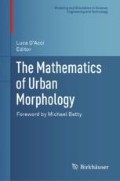Abstract
Urban density is a term used in urban planning and design to refer to the number of people inhabiting in a given urbanized area. Density and compactness are two closely related, but different, criteria relevant for the transformation of cities to become more resilient to climate change. While a high degree of compactness is desirable, too much density can be detrimental to liveability, health, and social well-being. More compact cities are an advantage and will help in curbing urban sprawl, but a consolidated urban form requires urban infill at densities that support compact self-reliant districts and mixed-use neighborhoods. The social dimension of such density increase is likely to be a future challenge and face community resistance. This essay argues that a quantitative approach to describe urban density helps to better understand cities; however, urban form is always more than just a mathematical formula, including nonquantifiable qualities of cities.
Access this chapter
Tax calculation will be finalised at checkout
Purchases are for personal use only
References
Bay, J.H.P., and Lehmann, S., eds. 2017. Growing Compact: Urban Form, Density and Sustainability. London: Routledge.
Beatley, T. 2014. “Imagining Biophilic Cities”, in: Low Carbon Cities, S. Lehmann (Ed.). London: Routledge.
Breheney, M., ed. 1992. Sustainable Development and Urban Form. London: Pion.
Churchman, A. 1999. “Disentangling the Concept of Density.” Journal of Planning Literature, 13(4): 389–411. London: SAGE.
Cuthbert, A. R. 2006. The Form of Cities: Political Economy and Urban Design. Oxford: Blackwell.
Density Atlas. 2011. Planning resource developed by MIT faculty, available online.
Farr, D. 2007. Sustainable Urbanism, New York, NY: McGraw-Hill Publishers.
Girardet, H. 2008. Cities, People, Planet: Urban Development and Climate Change, London: Wiley.
Hall, P. 1988. Cities of Tomorrow: An Intellectual History of Urban Planning and Design in the Twentieth Century. Oxford and New York: Blackwell.
Hall, P., and Pfeiffer, U. 2000. Urban Future 21: A Global Agenda for 21st-Century Cities. New York, NY: Spon.
Howard, E. 1998/1902. Garden Cities of Tomorrow. London: Faber & Faber.
Jacobs, J. 1961. The Death and Life of Great American Cities. London: Cape; New York: Random House.
Jenks, M., Burton, E. and Williams, K., eds. 1996. The Compact City: A Sustainable Urban Form? London: Spon.
Koolhaas, R., and Mau, B. 1995. S, M, L, XL. New York, NY: Monacelli Press.
Kostof, S. 1999. The City Shaped: Urban Patterns and Meaning Through History, 2nd ed. New York, NY: Thames & Hudson.
Lehmann, S. 2005. “Towards a Sustainable City Centre: Integrating Ecologically Sustainable Development Principles into Urban Sprawl.” Journal of Green Building, 1(3): 83–104.
Lehmann, S. 2010. The Principles of Green Urbanism. London: Routledge.
Lehmann, S. 2014. Low Carbon Cities: Transforming Urban Systems. London: Routledge.
Lynch, K. 1960. Image of the City. Cambridge, MA: MIT Press.
Mostafavi, M., and Doherty, G. (Eds.). (2010). Ecological Urbanism. Baden, Switzerland: Lars Mueller.
OECD. 2012. Compact City Policies: A Comparative Assessment. OECD Green Growth Studies. Paris: OECD Publishing.
Pont, M. Y., and Haupt, P. 2010. Spacematrix: Space, Density and Urban Form. Rotterdam: 001NAi Publishers.
Roaf, S. 2008. “The Sustainability of High Density. Population and the People”, in: Designing High-Density Cities for Social and Environmental Sustainability, E. Ng (Ed.), 2009, London: Earthscan: 27–33.
Rowe, C., and Koetter, F. 1978. Collage City. Cambridge, MA: MIT Press.
Rowe, P. G. 2015. “Urban Density as a Function of Four Factors.” YouTube podcast of Rowe’s presentation at the Centre for Liveable Cities, Singapore, September 2015. Accessed October 25, 2015, at www.youtube.com/watch?v=IXahgHQEuMI.
Toderian, B. 2012. “Density Done Well.” YouTube podcast of Toderian’s presentation at the Vancouver Urban Forum 2012, June 2012. Accessed October 25, 2015, at www.youtube.com/watch?v=eRk93Wgdv1g.
Author information
Authors and Affiliations
Corresponding author
Editor information
Editors and Affiliations
Rights and permissions
Copyright information
© 2019 Springer Nature Switzerland AG
About this chapter
Cite this chapter
Lehmann, S. (2019). Understanding and Quantifying Urban Density Toward more Sustainable City Form. In: D'Acci, L. (eds) The Mathematics of Urban Morphology. Modeling and Simulation in Science, Engineering and Technology. Birkhäuser, Cham. https://doi.org/10.1007/978-3-030-12381-9_30
Download citation
DOI: https://doi.org/10.1007/978-3-030-12381-9_30
Published:
Publisher Name: Birkhäuser, Cham
Print ISBN: 978-3-030-12380-2
Online ISBN: 978-3-030-12381-9
eBook Packages: Mathematics and StatisticsMathematics and Statistics (R0)

